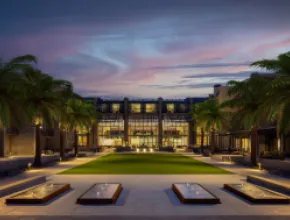If Disneyland is the apex of childhood fantasy—the ideal kids’ destination—then Southern Arizona is a strong contender for the king of adult getaways. Ask any overworked American to describe the perfect escape, and Southern Arizona seems to ably address it: blue skies with sunny days and starry nights; upscale resorts hidden away in tranquil natural settings; pure, clean air; world-class spas; and fine dining.
To complete the fantasy, however, you have to add a few things your day-dreamer probably left off, qualities that can’t be found anywhere else in the world and make this one of the most magical and distinctive destinations on the planet. There’s the enchanting Old West of cowboys and Indians, with an epic history that continues to flavor the culture today; the otherworldly flora and fauna of the surrounding Sonoran Desert; the rich blend of Hispanic and Native American heritage; the iconic red rock landscape. Southern Arizona is simultaneously the heart of the American West and the antithesis of modern, suburban America as it is thought of today.
But while infamous towns like Tombstone and Bisbee do offer a rare and authentic taste of a bygone era and a hauntingly beautiful desert setting, Southern Arizona is anything but antiquated. Without either paving over or forgetting its past, the region has mastered the delicate art of evolving symbiotically with its culture, history and environment.
"Southern Arizona has a really unique history and culture," explains Graeme Hughes, director of convention sales for the Metropolitan Tucson CVB. "We are highly influenced by our geography, our border with Mexico, our Apache Indian heritage—it all goes into things like our architecture or our restaurants."
So while children don’t care that everything in Disneyland is fake, Southern Arizona offers meeting planners that rare blend of authenticity and modernity: the state-of-the-art ballroom at the edge of the desert, the horseback ride before the Michelin-star meal, a wine tasting at O.K. Corral. Whatever your attendees do here, it will most certainly be unique.
Tucson Area
Tucson, with its dozen first-class resorts and modern convention center, naturally draws a significant share of the region’s meetings business and has the pedigree and variety of restaurants, DMCs, meeting venues, entertainment and recreation to enthrall groups from every pocket of the world.
"I thought it was just the right amount of sun, desert adventure, relaxation and starry nights to make any meeting or vacation a well-rounded experience," says Megan Higgins of Site Solutions Worldwide, who recently brought a group of 700 to the JW Marriott Starr Pass Resort and Spa for the annual joint conference of State Associations of Addiction Services and Network for the Improvement of Addiction Treatment.
As part of the conference, the group attended an off-site dinner event at Old Tucson Studios. In addition to its role as movie set for Hollywood Westerns, the facility offers daily Wild West entertainment, such as shoot-out reenactments, and is a natural choice for team building and other off-site events.
Higgins’ attendees also raved about visiting the Arizona-Sonora Desert Museum, a highly acclaimed facility that makes use of the natural desert environment to showcase everything from mountain lions to scorpions to incredibly resilient desert plants. In addition to the exhibits and nature walks, there is state-of-the-art meeting space and catering for upscale dinner receptions.
Planners have a surprisingly large selection of meeting venues and resorts to choose from for a city of Tucson’s size. The resorts themselves, which include such high-end standards as Omni, Loews, JW Marriott, Westin, Ritz-Carlton and Hilton, are tucked into the red rock hills above town, each in their own slice of remote desert wilderness and embracing completely different styles. There is literally a resort for every taste—Miraval for the Zen escape, Tanque Verde Ranch Resort for the cowboy ranch experience, The Westin La Paloma for an upscale desert hideaway with a Jack Nicklaus Signature course, or the Hilton Tucson El Conquistador Golf & Tennis Resort, another favorite for its championship fairways.
But while the case is often that meeting attendees in Tucson are so pleased with their resort that they don’t even think to leave the grounds, the real flavor of Tucson lies down in the city. With its strong influence from Native American and Hispanic cultures (both traditional and modern), the tone of the city is sometimes difficult to read at first, but is nonetheless fascinating.
"Don’t forget to also capitalize on the cultural diversity of the area by tying in the three heritage cultures: Texan, Mexican and Native American," Higgins says. "There is so much to offer your attendees in an area like Tucson."
Because of the diversity and overall excellence of the meetings resorts, coupled with Tucson’s abundant recreational and cultural options, meetings tend to go quite well.
"I give Tucson high marks," says Debra Silvestrin of the Association of Alternative Newsweeklies. "I was very pleased working with the CVB, using their website. The suppliers were great to work with, as was the car company we worked with. And the results from our survey were very positive—about 98 percent of attendees agreed that the convention was a success."
Silvestrin’s attendees, who also met and stayed at the JW Marriott Starr Pass Resort and Spa, were thrilled to experience one of the unique qualities shared by nearly all of Tucson’s resorts: an intimacy with the surrounding Sonoran Desert.
"Even though they were at a resort, the way it sits into the desert landscape, they get to experience it, to see the animals and wildlife," she says.
Outlying Areas
Planners can also find meeting options beyond the Tucson area. Just 35 minutes south of Tucson, near the tiny town of Tubac, the Tubac Golf Resort & Spa offers upscale accommodations, meeting space and premium golf in a setting that is as remote as it gets. The new Geronimo Conference Center adds 7,000 square feet of meeting space to the resort’s existing 6,000.
A bit farther south of Tubac, the Esplendor Resort at Rio Rico features 179 plush, Spanish-style guest rooms, an 18-hole, Robert Trent Jones Sr.-designed golf course and 11,000 square feet of meeting space.
For attendees with some free time and who really want to see the Old West, the historical towns of Tombstone and Bisbee are both within a two-hour drive of Tucson. In Tombstone, the infamous Western settlement, groups can tour an O.K. Corral museum, stop at saloons and restaurants along the main drag, and experience the town as it was during the time of its infamy (without the shoot-outs, of course). Bisbee, on the other hand, was once the home of the copper mining industry, yet today is both a thriving artist colony and a well-preserved town, considered emblematic of the Old West.
Yuma
Ranked by Money magazine as one of the top places to live in the U.S., Yuma sits at Arizona’s Southwest border with California along the bank of the Colorado River. Because of the river, along with nearby mountains, perpetual sun and 13 golf courses, recreation runs high on the list of things to do. Yuma also borders California’s Imperial Sand Dunes, a major recreation destination for off-road enthusiasts and campers. Finally, three national wildlife refuges surround Yuma, providing plenty of motivation for hikers, bird and nature watchers, and backpackers. Another major draw here is the Yuma Territorial Prison State Park, which held Arizona’s most notorious and dangerous criminals around the turn of the 20th century.
When the sun sets, the action moves to Yuma’s three casinos, where there are bars and restaurants, nightly entertainment and, of course, gambling. A fourth casino is scheduled to open late this year.
As for meetings, Yuma offers a whopping 4,000 guest rooms, 25 percent of which are from hotels built in the last two years. The city’s primary meeting venue, Pivot Point Conference Center, opened just last year with almost 20,000 square feet of meeting space.






